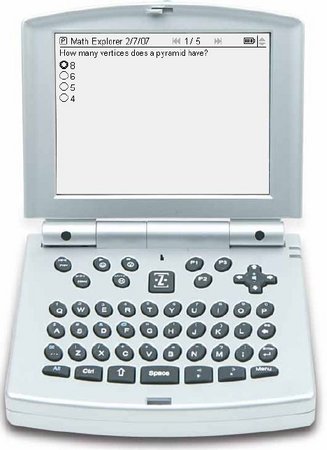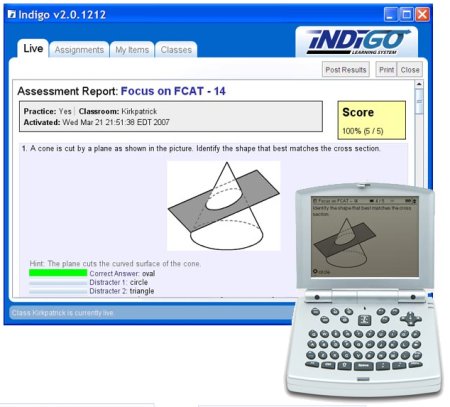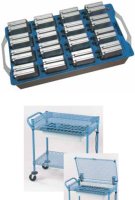Device profile: LearningSoft Indigo assessment system
Jun 1, 2007 — by LinuxDevices Staff — from the LinuxDevices Archive — 3 views LearningSoft has used customized Linux-based handheld devices in an “assessment system” aimed at helping classroom school teachers create, administer, and score tests. Aimed primarily at grades three through eight, the “Indigo Learning System” uses Aeronix's $99 Zipit chat device running a custom software… stack.
LearningSoft has used customized Linux-based handheld devices in an “assessment system” aimed at helping classroom school teachers create, administer, and score tests. Aimed primarily at grades three through eight, the “Indigo Learning System” uses Aeronix's $99 Zipit chat device running a custom software… stack.

The LearningSoft Indigo is a reflashed Aeronix Zipit
(Click for larger view)
LearningSoft is primarily in the business of selling testing or assessment software aimed at helping teachers educate students to state educational standards. Its Indigo assessment system comprises three components:
- Java-based “Classroom Manager” application that supports Linux, Mac, and Windows hosts
- “Test bank” with over 10,000 questions said to be aligned with state educational standards
- Teachers create tests by selecting questions from the bank, and then adding their own by cutting and pasting graphics and text
- An “enterprise-grade” wireless access point qualified with up to 32 simultaneous users (a 250-user “college” version is under development, the company said)
- The student device itself, a customized Aeronix Zipit running a custom Linux software stack

Components of the Indigo Assessment system
It works like this: a teacher assembles a test from off-the-shelf and custom questions, and then distributes it wirelessly to student devices. Students answer questions on the devices, and then turn their answers in electronically. Alternatively, teachers can freeze the client devices and collect test answers at any time, or according to a timed schedule.

The Classroom Manager application and Indigo client
(Click to enlarge)
As an assessment system, Indigo competes primarily with remote control-like “clicker” systems used in conjunction with projectors and multiple-choice tests. LeaningSoft says that in contrast to clickers, Indigo lets students work at their own speed, or even take tests at home. It also lets teachers include essay questions.
CEO David Cole said, “We pilot-tested the device with 1,000 students in Hawaii for 16 months, and learned a lot. One of the biggest things was the efficacy of the keyboard for composition. We never expected the length of compositions that were turned in.”
Pilot testing also led to the creation of a “barometric meter of understanding,” Cole said. “A teacher came up with the idea for this simple application. A bitmap of a happy face, and one of a sad face, are downloaded. The job for the student is to scroll to the happy face if they get it, and the sad face if they don't.”
Additional claimed benefits of the Indigo system include:
- Teachers can view all Zipit screens centrally, to monitor student progress throughout a test
- The teacher can send messages or questions to a single student, all students, or a group, and receive their answers in real time
- If a Zipit is in danger of falling asleep due to inactivity, the teacher is sent an alarm
- Creates a more “fluid” testing environment that paper and pencils, with greater student excitement and interest
How it works
The Indigo client device is a customized version of the Aeronix Zipit, a $99 device originally marketed as an instant messenger and music player appliance for kids, to keep them from tying up the family PC for hours each evening.
According to Cole, LearningSoft investigated distributing tests via infrared and USB-stick, before concluding that WiFi was the way to go and approaching Aeronix about an OEM arrangement. “What they built for us would have been no different if we had paid the NREs [non-recurring expenses] and written the spec ourselves,” Cole said. “It is very close to the perfect assessment device.” He added, “We looked at using Palm Pilot-like devices, but those cost $300, and you have a keyboard and a wireless device hanging off of it. You end up with an abomination.”
The Zipit is based on a Cirrus Logic EP7312-CR-90, an SoC (system-on-chip) with a 90MHz ARM720T core. The device has a QVGA (320×240) display that shows 16 levels of gray. Claimed battery life is 10 hours of continuous use — enough for two days of use between charges, according to CTO Sunil Gupta.
An 802.11b Agere WiFi chip and a thumb keyboard afford the only interfaces that do not require soldering. Cole said, “Everything that goes out over WiFi is encrypted, because we wanted to guard against malicious code reflashing — somebody writing a virus that turns them into bricks.”
On the software side, LearningSoft used a community-sourced buildroot environment to generate its filesystem. It then added its custom “assessment app,” developed in C and assembly. Compared to the stock Zipit, the Indigo client “drives the display more aggressively,” according to Cole. Gupta adds, “The assessment app controls the whole device, using Microwindows as the GUI.”
The Indigo/Zipit client runs the Linux kernel and LearningSoft's custom C/assembler application from 2MB of NOR flash, using execute-in-place (XIP) technology for instant-on and -off. Gupta commented, “We have a 64KB boot partition, 512KB kernel partition, 128KB dedicated to the /usr partition, and the rest devoted to the root filesystem.”
Ironically, LearningSoft bases its Zipit software on Ken McGuire's Linux patchset for the Zipit — ironic, because Aeronix did not exactly welcome the hardware hacker community with open arms, early on, in part due to child safety concerns, according to Aeronix Founder Ralph Heredia. Now, though, the company clearly benefits from community work.
Features planned for future releases include an eBook reader, a note processor, and even proxy-based web browsing to teacher-specified URLs. Asked about the practicality of web browsing on a device with 16MB of RAM, Gupta said, “Our assessment client is fundamentally based on HTML rendering, because we came from the ASP world. We've been browser-hosted from the beginning, with support for a limited subset of HTML. Most of the work was on the proxy, which runs on the teacher's system.”
 Charger and security cart (Click to enlarge) |
Also in the works are versions of the product with a new simplified interface, for grades one and two. Cole said, “Not to sound too cynical, but more money is available for younger students, because investments there tend to bear more return.”
High school students, too, could one day find themselves taking tests on an Indigo. “Starting in ninth grade, there's a transition from using state standards to using particular course titles as the basis for testing. So the test bank will have to be another SKU.”
Availability
The Indigo Assessment System is available now, priced at $2,700 with 16 units, $3,500 with 24 units, and $4,300 with 32 units. A 32-unit charging station costs $600, while a lockable security cart goes for $400. Additional student units are, like the original Zipit, priced at $100.
This article was originally published on LinuxDevices.com and has been donated to the open source community by QuinStreet Inc. Please visit LinuxToday.com for up-to-date news and articles about Linux and open source.